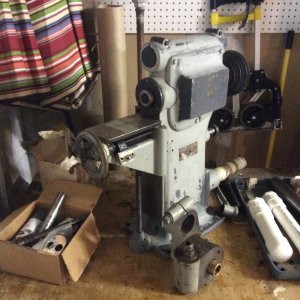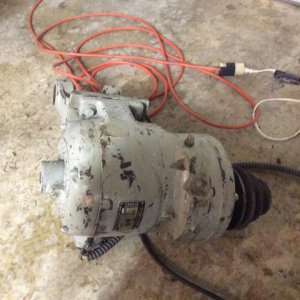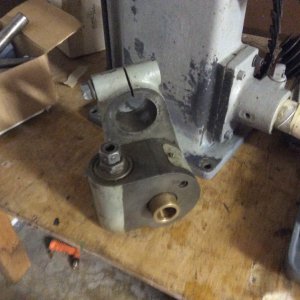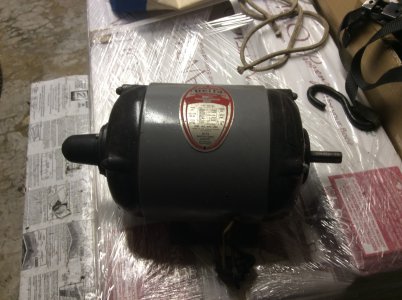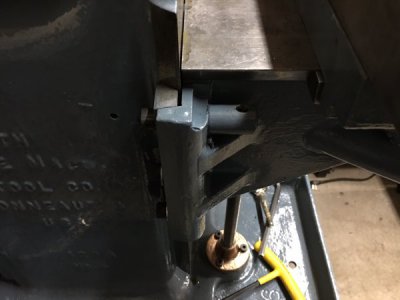I am going to paraphrase the responses you got on the Yahoo group, without the rabble:
Some Burke #4s have a Master type RA 3/4 HP single phase 110 volt gear head motor. Mine is 220/440. This motor is a repulsion-induction type motor, which reverses its direction by shifting the brushes. The rear bearing on the motor appears to be a sleeve bearing, as it has an oil "cellar" (a kind of reservoir for lube oil set below the level of a bearing). First , check if there is any oil in gear case. There are some screwed plugs on the gear case. The Master gear head motor on a Burke number 4 mill is usually mounted on a bracket that Burke furnished with the milling machine. This bracket bolts to the mounting feet on the motor. The result is the motor and gear case are oriented so the mounting feet are at some angle rather than level or nearly so. Start by removing the plugs on the gear case and seeing if any oil is left in it.
The rotating element in an AC motor of this type is referred to as the "rotor" rather than "armature." The rotor has two bearings - one is at the tail end, and is mounted in the end-bell of the motor casing. The front bearing may well be set in the front wall of the gear case. The pinion of the reduction gearing may be machined on the rotor shaft. This is an old-style gearhead motor, where the motor and gear case have to be assembled together since there is no front end-bell on the motor. The rotor shaft with its pinion gear passes thru a clearance hole in the "bulkhead" on the gear case. This bulkhead separates the gear case from the motor casing. A slinger (disc) on the rotor shaft is fitted to prevent any of the oil in the gear case from migrating into the motor casing. No oil seal used. The rotor shaft/pinion has a front journal that is supported in a bearing in the front wall of the gear case.
Check for oil in the gear case if you are hearing squealing, and if none is found, fill initially with diesel fuel or kerosene and run for maybe 3 0 seconds, then drain. This should flush out any sludge and get the kerosene worked up into places that have not seen oil for some years. After draining the kerosene, fill with oil. For light duty, and getting slung up to lube possible sleeve type bearings, use an ISO 68 oil, and maybe add a little Lucas Oil Extender. This is an additive sold in automotive stores. It has tackifiers, and causes the oil film to "stick" to gear teeth a bit better.
It is possible that the noise you are hearing is the centrifugal switch inside the motor. This is a switch that energizes the start windings (in single phase motors) so the motor will start turning when it is turned on. This switch will open the start winding circuit when the motor reaches about 3/4 of its rated RPM.
It is composed of a rotating piece (mounted on the rotor shaft) with counter-weights that mechanically overcome spring tension when the motor reaches a specific RPM. This usually involves a rotating ring (which is part of the centrifugal starting device) that is in physical contact with a stationary set of contact points. Hence, they are rubbing against one another until the motor reaches an RPM that causes the centrifugal weights to pull the contact ring away from the switch and break the start winding circuit. If you can, plug the motor in and see if the squealing stops when the motor spins up to speed. If you are in doubt, take it to a motor shop and ask them about the noise.
The ISO 68 oil is still thin enough to lube sleeve type bearings and won't hurt older bronze bearings. Get some oil in the gear case and tail bearing of the motor, if it is a Master type RA 3/4 HP single phase 110 volt gear head motor.
Do not be too quick to discard that Master gearhead motor. Clean it, lubricate the gear case and tail bearing, and see if it quiets down. If not, it can be rebuilt.
